Spring 2017 update: Prolific pasture key to new born lamb welfare
By Patrick Francis
For our 2017 lambing, we went a step further to ensure new born lambs and their mothers were protected from the usual bitterly cold and windy conditions that prevail in August and September. These are nature’s preferred lambing months with Wiltipoll sheep because the ewes’ oestrus cycle strength and frequency peaks in March, April as does the rams’ libido. In other words, the Wiltipolls natural breeding cycle peaks in autumn so ewes naturally lamb in late winter to early spring. This lambing time is also nature’s way of coinciding with annual peak pasture growth to support ewe lactation and lamb growth up to early summer when the lambs are weaned.
By working with nature in this way farm productivity is rewarded with optimum lambing percentage, and optimum pasture growth to support ewe milk production and lamb growth rate. Applying some simple management techniques supports these natural cycles in the sheep and the pastures.
In our holistic grazing management system, pastures in some paddocks are not grazed during flowering due to the long rotation involved. Species like tall fescue and cocksfoot flower and set seed on long, strong stems in late spring early summer. Unlike conventional grazing management which aims to prevent grasses from flowering as it is considered “wasteful” of pasture, allowing this to happen is not a problem for us because:
- It encourages the desired perennial grass plants to grow longer roots and larger diameter crowns. This means the plants store more energy in their roots and re-grow quickly after each grazing. The plants are more resilient to variable rainfall and temperature. The plants have a much longer life span so our pastures are more persistent than conventionally grazed pastures.
- Because many of our perennial grasses are summer active species, they continue to produce green leaves from new tillers emerging out of the crown after rainfall. The presence of dry flower stalks doesn’t seem to deter new tiller growth, providing high intensity intermittent grazing is practiced post first flowering. So our pastures grow green feed over summer and early autumn even when dry stalks are present. Another feature of the summer active species we grow is that the dry flower stalks act like structural pillars for emerging leaves in new tillers, holding them up to a height of 30 – 40 cm.
The structural integrity of the dry stalks plus long- rest rotational grazing is what provides new born lambs with vital protection from cold and wind in August/September, figure 1.
Figure 1: A suite of lamb welfare, ewe nutrition and ecosystem function outcomes are achieved with perennial pastures managed for cold, wet and windy weather protection. Note the height of the green pasture and the dry stems compared to the lambs – they are in a virtual wind free zone. Photo Julie Francis.

In contrast to the pasture management practiced on Moffitts Farm to ensure ewe and lamb health and welfare and pasture resilience, the majority of sheep farms are managed for far lower pasture mass, figure 2. This leads to far higher lamb mortality (industry data shows approximately 30% of twins and 10% of single lambs die at or soon after birth) and a continual battle to control intestinal worm parasite loads in ewes and lambs. As well, the pastures have such short root systems due to constant grazing that they require regular fertiliser applications to supply nutrients for growth, are far more susceptible to insect pest attack, and are having to be regularly re-sown as they lack resilience to survive in the face of dry summer and autumn events. On-top of all these negative consequences, these short pastures with a high proportion of bare ground between plants cannot support above and below the surface biodiversity which ensures ecosystems functions are operating effectively across the paddock.
Figure 2: Conventional grazing management as practiced by many sheep farmers across southern Australia, means ewes lamb in paddocks that lack sufficient green pasture mass for adequate nutrition and protection for lambs from extreme weather events. Industry data shows approximately 30% of twins and 10% of single lambs die at or soon after birth mostly from ewe nutrition and weather related issues. Photo: Patrick Francis.
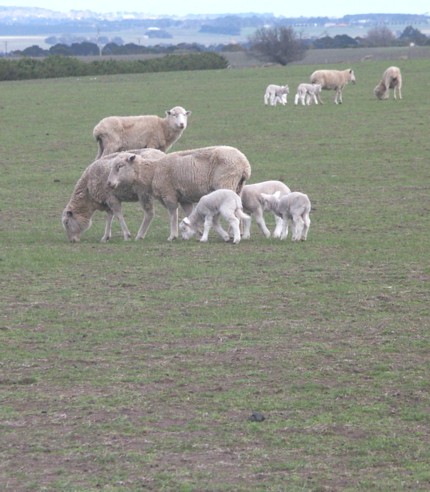
In Moffitts Farm pasture management there is a temptation to slash (often called topping) the long dry flower stalks in summer. Many farm advisors consider they suppress paddock livestock carrying capacity and are pasture feed wastage. In other words, if more livestock were carried on the farm which ensured plants did not flower then the conversion of pasture into livestock products would be far more efficient. Our individual paddock carrying capacity records (started in 1996) indicate this is not the case. Some farmers contend the dry flower stems are a fire risk but we disagree because in our summer active perennials, the green leaves significantly impede grass fire spread.
In summer 2017 the dry flower stalks were not slashed in any paddocks (except for fire prevention management adjacent to buildings). The lambing paddocks were grazed as part of the normal rotation in January and May, then left ungrazed for 14 weeks until 6 August when the about to lamb ewes were allowed in. On this date the paddocks had approximately 3000 – 4000 kg of green dry matter present with green leaves held up by the dry flower stalks grown the previous December. The effect was a no-wind zone across the paddocks to a height of approximately 30 cm above the surface, figure 1. The lambs were born into this no-wind zone and their mothers had 30cm high green pasture to graze before and after lambing.
Another advantage of the pasture mass present is it enables ewes to establish private birthing areas anywhere across the paddock which they can stay in for 6 – 8 hours prior, during and after lambing. Other ewes seem to keep away from these birthing areas. (In contrast where weather protection is only provided by shelter belts in or around lambing paddocks, often ewes will lamb close together on bear soil under the shelter leading to lamb miss-mothering due to lambs crossing between ewes and ewes walking away to find pasture to eat).
Our lambing was 90% over in two weeks and finished in four weeks. Over this period there were two sustained extreme weather episodes where wind chill dropped the temperature below 0C for hours and for three to four days in a row, Figure 3.
Figure 3: August and September can have severe weather conditions where wind chill reduces temperature below zero for hours on end. Our prolific pasture mass in lambing paddock eliminates the wind chill effect as wind speed to 30cm above the surface where new born lambs reside is reduced to 0. Data source: BOM.

Not a lamb died due to exposure during such severe conditions. The reasons why, I contend, were the excellent protection for lambs from wind across the entire paddock, and the ideal nutrition available to the ewe before and after delivery in the birthing zone.
The outstanding lamb survival result is not the only outcome from retaining dry flower stalks in pasture using a long-rest rotational grazing method. Other advantages are:
- The ewes are lambing on a pasture which has a reduced load of infective internal worm larvae waiting to be ingested. And even with infective worm larvae present, these organisms inhabit the earth surface and leaves close to the surface. With the majority of leaves 20 – 30cm above the surface, intake of infective larvae is minimised, figure 4. Compare the grazing zones for sheep and for lambs once they are three weeks old between figure 2 and figure 4
- Pasture with this level of green dry matter present protects the biodiversity living under on and above the soil surface.
- The level of pasture means all rainfall is retained in the paddock. Runoff only happens when winter monthly rainfall is above average and soil becomes saturated. The high level of green and dry herbage material across 100% of the soil surface prevents pugging from animal hooves during saturated soil episodes.
Figure 4: A another unheralded advantage of high pasture mass in lambing paddocks is the way it allows ewes and lambs (which start eating pasture at about 3 weeks of age) to graze leaves that are above the zone where infective internal parasite larvae congregate. Photo: Patrick Francis.

Other developments
Rainfall on Moffitts Farm has been extremely variable in 2017 despite neutral ENSO and IOD impacts (see www.bom.gov.au ). Most months have been below average with June being a record low for the month with only 8mm (average is 66mm). Fortunately April produced above average rainfall and August achieved average rainfall. In August our creek started to flow for the first time since December 2016, and some water collected into dams, mostly from sub-surface flow.
Spring is looking decidedly uncertain as September rainfall was half the average and October has been exceptionally dry. The creek has stopped flowing. These are generally our two wettest months and help set up a substantial pasture bank to take the livestock through summer. Despite the dry conditions pasture growth has been reasonable with the two ewe and lamb flocks rotating through paddocks starting with 3000 – 4000kg green dry matter per hectare. They are shifted out when pasture is eaten down to around 1800kg green dry matter.
Our spring 2016 sown trial with lucerne and chicory grown together has been successful as has the plantain trial. Chicory and plantain are herbs which provide ruminants with an alternative source of nutrients to conventional grasses. They complement our pasture species approach of providing livestock with complex pasture diet based around a wide range of grasses, legumes and herbs. This spring I have sown lucerne, chicory and plantain together in two more paddocks for a high quality summer active pasture suitable for finishing lambs to the required market weight of 50kg.
A bonus with this pasture mix is that chicory and lucerne are summer active responding quickly to summer rain while plantain stays green over summer but grows more strongly in autumn and winter. These paddocks will double as sheep refuge areas if a grass fire threatens the property.
Two paddocks in our pasture renovation program will be direct drill sown with Winfred brassica to provide another source of high quality pasture for finishing lambs in summer, autumn and winter. This year, the spring 2016 sown brassica continued to be rotationally grazed until early September 2017. Lamb growth rates on the brassica were always above 200g/day.
Figure 5: Lambs grazing a lucerne and chicory paddock in February 2017. Growth rates were 250 – 350 g/day during the rotation. Note how the paddock is entirely green compared with a grass dominated pasture in the background which is feeling the effects of below average rainfall in January and February. Being green this paddock is an ideal refuge if fire threatens. Two more paddocks were sown this spring with the herb plantain added to the mix. Photo: Patrick Francis.
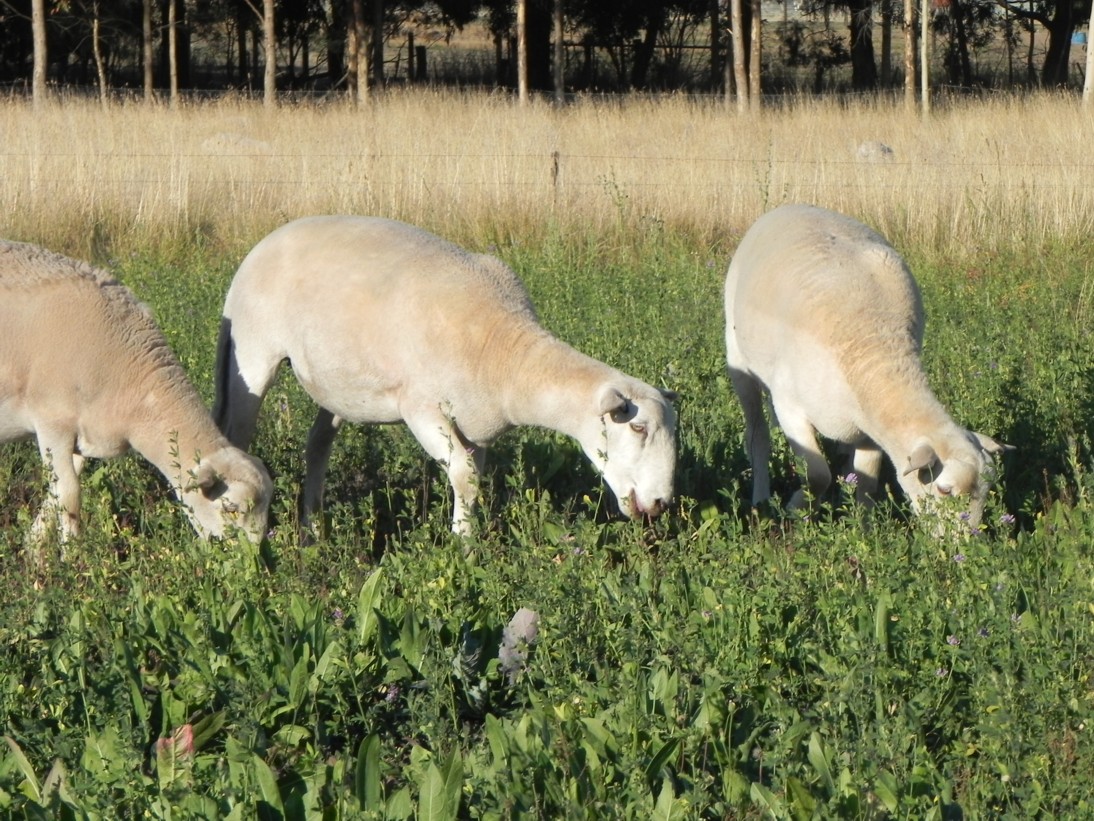
Fox control
Fox control is a continuous process on Moffitts Farm. Foxes are unwanted introduced feral pests which prey on wildlife as well as new born lambs. Land owners have a responsibility under the Catchment and Land Protection Act to control foxes so that local biodiversity is protected. Moffitts Farm is a Land for Wildlife property with 23% of its land area fenced off for conservation corridors, riparian corridor and forestry blocks.
Coupled with a grazing management which retains 100% pasture ground cover across all paddocks, the property is seeing a continual increase in native animal and bird biodiversity. Foxes are the constant threat to this biodiversity as well as to new born lambs.
Unfortunately neighbouring land owners have no interest in fox control on their properties. Our fox control program involves multiple approaches:
- Boundary and lambing paddock fences have had wire netting, bent over at the bottom to make a footing, added to them to impede easy access by foxes.
- 1080 Foxoff baits are laid where the presence of foxes (trail and or scats) has been identified in riparian or conservation corridors. A wildlife day and night movement camera is used to help identify fox presence in a particular area, figure 6.
- A solar light array has been erected on a small tower in the lambing paddocks. These lights look like torches – I have no evidence that they deter foxes, but they might help.
- Lambing ewes are regularly inspected during the day as well as a late night walk with a spot light. A shotgun is carried on these inspections in case a fox enters the lambing paddock.
- Paddock hygiene is maintained by picking up all afterbirths (placentas) in the birthing zone. If any lamb dies it is also removed once the ewe has left it. These are incinerated to prevent fox scavenging.
Figure 6: Fox predation of lambs and wildlife is a constant threat which is countered with infrastructure, surveillance and direct action. Movie footage shows this fox unearthing a 1080 bait placed close to the small post. Photo: Wildlife camera Moffitts Farm.
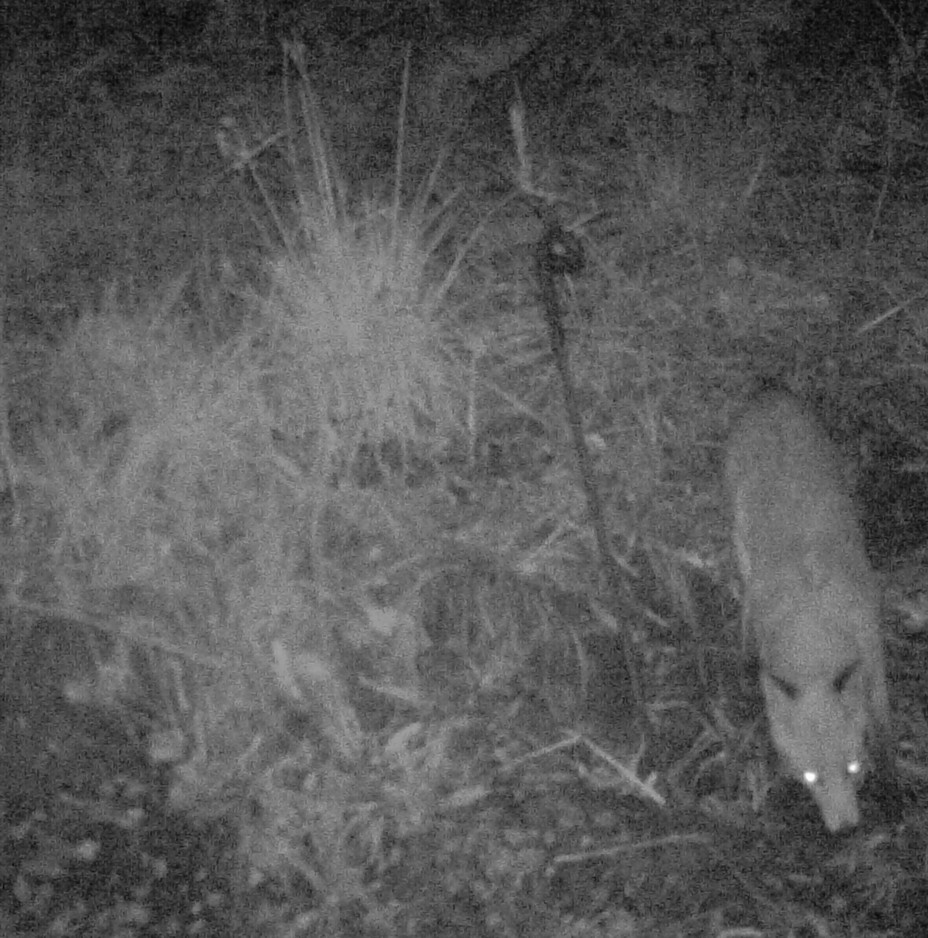

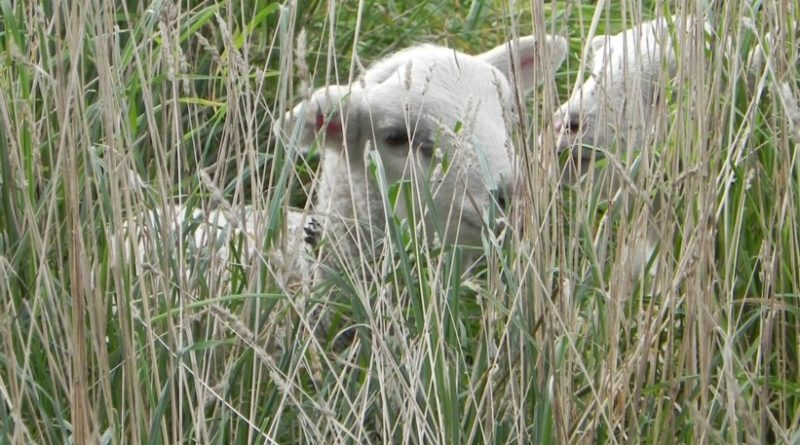
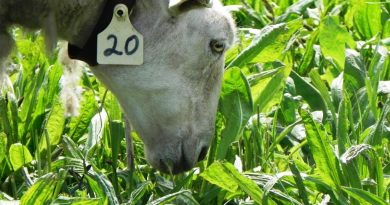
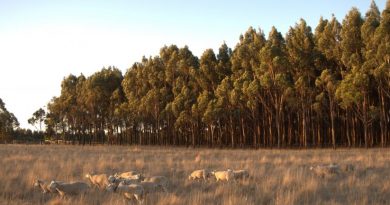
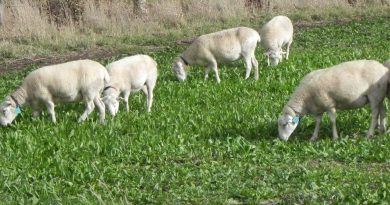
Thank you for this great website. I’m a hobby farmer of wiltipolls in my first planned lambing season ? I have 2 young alpaca Wether with my little flock and despite neighbours complaining of lamb losses to foxes I have not had any and my alpacas do a wonderful job of attending to any ewes or lambs that are isolated from the flock. They were bonded into the flock 8 months before lambing and I believe this is an important factor in the success of alpacas as herd guards. They’re also wonderful, charismatic animals who are easy to handle if you invest time in letting them get to know you.
In the coming years I will be following a lot of your successful pasture planting to optimise my property for sustainable animal husbandry. So thanks again for sharing all of the info